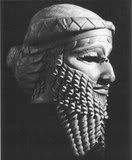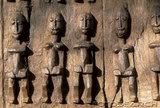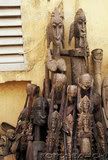Friday, June 1, 2007
African Roots of Humanity and Civilization - Part IV - Americas
THE AFRICAN PRESENCE IN EARLY AMERICA
The First Americans
Most modern scientists believe that the earliest immigrants to reach the Western Hemisphere were Asian Mongoloids. It would appear, however, that this general view ignores evidence that strongly suggests that the first people to arrive and settle in the Western Hemisphere were Black people of very ancient African ancestry.
European-American archaeologist Harold Sterling Gladwin (1883-1983) advanced that the first actual migrants to America were Afro-Australoids. The Afro-Australoid migrations to America probably began about 40,000 years ago and lasted for several millennia. These migrants are called "Australoids" because of their close physical and cultural relationships to the people who more than 50,000 years ago colonized much of Asia and Australia.
One of the most well-documented single pieces of evidence for the presence of Afro-Australoids in the prehistoric Americas during the period of Gladwin's writing was the Punin Skull: a female crania found in 1923, embedded in a stratum of volcanic ash near the small village of Punin in the Andean region of Ecuador. In addition to the skull itself, the stratum yielded the remains of a number of long extinct mammals; including an Andean horse--an animal known to have been extinct for more than 10,000 years. The Punin Skull's recovery by the American Museum of Natural History of New York created a sensation. It was, first of all, hailed as the earliest evidence of humans in the Americas, and, secondly, it was clearly of an Afro-Australoid type. On these two issues "the leading experts" agreed. According to British anatomist Arthur Keith (1886-1955):
"When the expedition returned to New York from Ecuador, the skull was transferred to the Anthropological side of the Museum, where it was examined and described by Drs. Louis R. Sullivan and Milo Hellman. Both anthropologists were struck by its resemblance to the skulls of the native women of Australia. I agree with them; the points of resemblance are too numerous to permit us to suppose that the skull could be of a sort produced by an American Indian parentage. We cannot suppose that an Australian native woman had been spirited across the Pacific in some migratory movement and that afterwards her skull was buried in a fossiliferous bed in the high plateau of Ecuador...The discovery at Punin does compel us to look into the possibility of a Pleistocene invasion of America by an Australoid people."
Harvard anthropologist Earnest Houghton echoed Keith, although in somewhat less detail:
"The Punin skull, found in 1923 in a fossiliferous bed in the Andean highlands of Ecuador...is a skull that any competent craniologist would identify as Australian in type. It is easier to find Australoid-looking dolichocephals in the more ancient burials in the New World than anything in the way of a skull that resembles a Mongoloid."
The second migration to the Americas, Asiatic-Africoids, began about 15,000 years ago. These migrants' physical appearance seems to have resembled the Melanesians--the proud Black Islanders of the South Pacific. After having first penetrated their way northward up the coasts of Asia, they began to gradually enter North America, where they ultimately developed the revolutionary and highly pivotal Clovis and Folsom fluted-point tool industries.
Clovis and Folsom were the respective locations (both of them in New Mexico, U.S.A.) that provided the first evidences of the earliest projectile points associated with the Big Game Hunting Traditions of North America. Clovis points have been reliably dated to between 11,000 and 11,500 years before present. Folsom points, which are usually smaller, more refined and sophisticated than their Clovis antecedents, were actually identified before the Clovis points, and have been dated to about 10,000 B.C.E. Both Clovis and Folsom spearheads were several inches long and were characterized by smoothly fluted or grooved channels extending lengthwise along both faces. Their precision and firepower were revolutionary and awesome; and their rapidly widespread usage, with the increasingly greater food supplies that resulted, laid the basis for steadily larger American populations.
It is of further interest that the first known modern discovery and revelation of the existence of these tool industries was made by an African-American; a tantalizingly and frustratingly obscure, self-taught naturalist and archaeologist named George McJunkin. The son of slaves, McJunkin, whose name may be searched for unsuccessfully in most history books, made the find in 1908 while riding out to check fence posts at a flooded creek. In 1925, three years after McJunkin's death, a dig at the Folsom site revealed a 10,000 year old spear point piercing the ribs of an extinct species of bison. It was McJunkin though, the obscure African-American, who had first documented Folsom points, which were then regarded (this was before the discovery of Ecuador's Punin Skull) "as the first unequivocal evidence of late Ice Age humans ever unearthed in the Americas."
The Clovis-Folsom Point Blacks seem to have come to North America in relatively small numbers. Later migrations of essentially the same physical type populated most of the rest of North America south of Canada. Their movements into the New World were then slowed, and later halted altogether, by the Australoid populations that were already well established in the North American Southwest. The later period Basket Makers of Arizona (the prehistoric culture bearers who eventually evolved into North America's Pueblo peoples) were probably the result of a fusion of Clovis-Folsom Point Blacks with the numerically larger Afro-Australoid populations.
Fossil remains of these early Black folk have been found in Baja, California, northeastern Mexico, Central America and in various parts of South America. Ancient Mongoloids, it now appears, followed the early Black immigrants and, after several thousand years, became the dominant people in the New World. Gladwin himself stated that, "The arrival of the Eskimo along the Arctic Coasts marked a fundamental transition in the anthropological history of North America. It was the last of a series of long-headed migrations, and the broad faces and slant eyes of the Eskimo marked the initial stage of a long period of Mongoloid domination in lands where Mongoloid people had therefore been unknown."
Mongoloid peoples, in fact, were soon coming to the Americas in such massive numbers, crossing the Bering Strait in boats rather than across the Beringia land bridge, that they eventually almost totally absorbed the New World's earlier arrivals. The resulting fusion of peoples constituted the native American populations at the time of the catastrophic European intrusions during the fifteenth and sixteenth centuries. The earlier arrived Blacks (the very first Americans) tended to fade away with increasing rapidity into the shadowy realms of fairy tales, myths and legends. Some native legends of the Americas abound with exploits of early Black people. An Inuit legend, for example, explains that:
"A man and his wife and their only daughter lived in a remote place. Their daughter was outside, working when she saw a big black speck moving along the ground, coming towards her. When it got closer, she realized it was a man with a sledge. The man and the sledge were all black. He came towards the house, stopped, and said to the girl, `I have come to take you with me.' He was black all over, even his face. The girl replied, `Very well. I'll go and tell my parents.' She entered the igloo and the man followed her. He stood outside the door and told the father, `I have come to take your daughter away with me.' The father replied, `I won't have my daughter going away with a black man like you.' The stranger became angry and made a step forward with his right foot. The whole house shook. Then the father said to his daughter, `My daughter, you'll have to go away with this man. This will go badly with us if you don't.' She got ready and left the house, with the stranger behind her. Before leaving, he put his left foot down hard on the floor and the house shook again. He went out, put the girl on the sledge and shoved the sledge because it had no huskies. After a while they saw a house--the man's house. They stopped and entered. Everything inside was black, and his parents also were completely black."
For the Greenlander, the color black symbolizes strength and wisdom--traditionally he was not allowed to wear black boots until he had become a skilled hunter and reached a respectable age--but black is also associated with spirits and occult forces. In the Southwest Indian story of the Emergence, a story that is as important in the region as the Book of Genesis is to Christians, the First World is called the Black World.
The First Civilization of the Americas: The Olmecs
The Olmec (2000 B.C.E. to 300 C.E.) were an early people of Meso-America, who settled the Mexican Gulf Coast. This ancient American culture been labeled the first civilization of the western hemisphere, as they surpassed their neighbors in an attempt to settle certain problems of living together--of government, defense, religion, family, property, science and art. In this endeavor, the Olmecs laid the foundations of American civilization. No one knows whence the Olmecs came or whether they were direct derivatives of the indigenous population; but that much of their sculpture, especially the colossal heads, evidences an ancient Africoid presence in the Americas is beyond sane rebuttal. In fact, some scientists have concluded that the Olmecs may have originally have been an African settler-colony which conquered the indigenous population of southern Mexico. Others are convinced that the Black presence among the Olmecs merely consisted of a small but elite and highly-influential community.
Sculptural and skeletal remains found in ancient Olmec sites provide the most conclusive evidence yet discovered concerning the presence of African people in America before Columbus. The most pronounced and widely acknowledged Africoid sculptural representations to appear in the ancient "New World" were produced by the Olmecs. At least fifteen colossal stone heads, weighing ten to forty tons, have been unearthed in Olmec sites along the Mexican Gulf Coast. One of the first European-American scientists to comment on the "Olmec heads,"archaeologist Matthew Stirling, described their facial features as "amazingly Negroid."
In 1974, Polish craniologist Andrzej Wiercinski informed the Congress of Americanists that skulls from Olmec and other pre-Christian sites in Mexico (Tlatilco, Cerro de las Mesas and Monte Alban) "show a clear prevalence of the total Negroid pattern."
Other scientists have found a host of cultural parallels between ancient Africans and native Americans, including architectural patterns and religious practices. As for the latter, some native American communities worshipped black gods of great antiquity, such as Ekchuah, Quetzalcoatl, Yalahau, Nahualpilli and Ixtliltic, long before the first African slave arrived in the New World.
Harun Kofi Wangara (1928-1989) wrote that:
"Black seamen, who can be specifically identified as Mandinga, brought the West African gold trade to the Americas. This is established through African designations for gold, the West African method of alloying gold, its ceremonial as well as trade value and, more important, the identity of the Blacks who trafficked in it."
During his third voyage, Columbus recorded that when he reached Haiti the resident population informed him that Black men from the south and southeast had preceded him to the island. In 1513, Balboa found a colony of Black men on his arrival in Darien, Central American.
All of these facts, buttressed by skeletons and sculptures, make it clear that African people have had a profound presence and influence in pre-Columbian America. Some scholars, such as Carlos C. Marquez, have even concluded that "the youthful America was also a Negro continent.
http://africanherbals.com/african_roots_of_humanity
_and_ci.htm
Labels: African Roots of Humanity and Civilization - Part IV - Americas
Subscribe to Comments [Atom]







